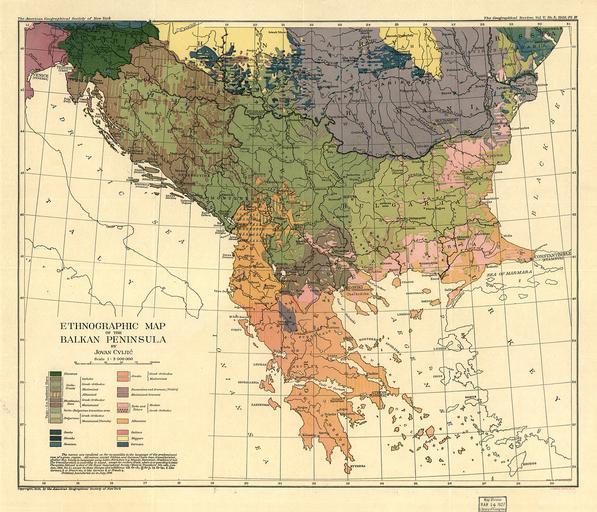MAKE A MEME
View Large Image

| View Original: | Cvijic,_Jovan_-_Breisemeister,_William_A._-_Carte_ethnographique_de_la_PĂ©ninsule_balkanique_(pd).jpg (1194x1024) | |||
| Download: | Original | Medium | Small | Thumb |
| Courtesy of: | commons.wikimedia.org | More Like This | ||
| Keywords: Cvijic, Jovan - Breisemeister, William A. - Carte ethnographique de la PĂ©ninsule balkanique (pd).jpg La dissolution de l'empire austro-hongrois Ă la fin de la Première Guerre mondiale transforma l'organisation politique des Balkans La guerre avait commencĂ© dans les Balkans avec l'assassinat de l'archiduc François-Ferdinand de Habsbourg par un militant serbe de Bosnie qui voulait l'indĂ©pendance de son pays vis Ă vis du double empire Jovan Cvijic l'auteur de cette carte ethnographique des Balkans publiĂ©e en 1918 par la SociĂ©tĂ© gĂ©ographique amĂ©ricaine de New York Ă©tait professeur de gĂ©ographie Ă l'universitĂ© de Belgrade Cvijic termina son doctorat Ă l'universitĂ© de Vienne dans les annĂ©es 1890 en formations gĂ©ologiques et gĂ©omorphologie physique mais ses centres d'intĂ©rĂŞts se tournèrent plus tard vers la recherche anthropogĂ©ographique analysant les influences gĂ©ographiques sur la dynamique ethnique et culturelle dans la pĂ©ninsule des Balkans La carte de Cvijic est un tĂ©moignage de la diversitĂ© ethnique religieuse et nationale des Balkans mais elle donne peu de notion des dommages dĂ©mographiques que la guerre causa sur la pĂ©ninsule oĂą l'on estime qu'un quart des populations d'avant-guerre de la Serbie et du MontĂ©nĂ©gro disparut l'un des plus haut taux de victimes de tous les pays combattants en The dissolution of the Austro-Hungarian Empire at the end of World War I transformed the political organization of the Balkans The war had started in the Balkans with the assassination of the Habsburg Archduke Franz Ferdinand by a militant Bosnian Serb seeking independence for his country from the dual empire Jovan Cvijić the author of this ethnographic map of the Balkans published in 1918 by the American Geographical Society of New York was a professor of geography at the University of Belgrade Cvijić completed his doctorate at the University of Vienna in the 1890s on geological formations and physical geomorphology but his interests later shifted to anthropogeographical research analyzing the geographical influences on ethnic and cultural dynamics in the Balkan Peninsula Cvijić ™s map is a testament to the ethnic religious and national diversity of the Balkans but it provides little sense of the demographic damage that the war wreaked on the peninsula where an estimated one-quarter of the prewar populations of Serbia and Montenegro were killed one of the highest casualty rates of any combatant country http //www wdl org/fr/item/93/ 1918 Cvijic Jovan ; Breisemeister William A PD-old Old maps of the Balkans Maps showing history in French Historical maps of ethnic groups in Albania Historical maps of ethnic groups in Bulgaria Historical maps of ethnic groups in Greece Historical maps of ethnic groups in the Republic of Macedonia Historical maps of ethnic groups in Montenegro Historical maps of ethnic groups in Romania Historical maps of ethnic groups in Transylvania Historical maps of ethnic groups in Serbia Historical maps of ethnic groups in Vojvodina Historical maps of ethnic groups in Turkey Historical maps of ethnic groups in Kosovo Historical maps of ethnic groups in Bosnia and Herzegovina Historical maps of ethnic groups in Croatia Historical maps of ethnic groups in Slovenia Maps showing 19th-century history Jovan Cvijić Historical maps of ethnic groups in the Balkans Images from the World Digital Library Images from the Library of Congress | ||||